
Prepared on Notepad by Ian Smith,
This page created on 13th January 2004, updated 8th February 2011

The Long Buses, RML 880-RML903, RML2261-RML2760
Part Five: 2000 Onwards: The future is bright; the future is bleak.
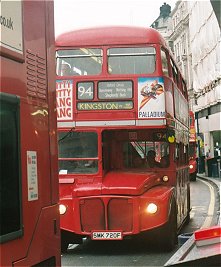
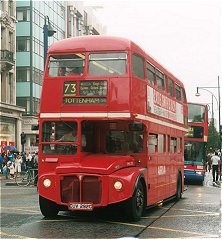 The RML entered the new millenium with a bright future.
The London Mayor, and his transport advisors, made very positive statements about them.
Under the surface arguments raged. There were supporters of the basic concept of the RML,
who pointed out the advantages of the quick loading/unloading of the open platform buses,
especially along congested Oxford Street.
Provided the basic shells remained robust,
as they seemed to be doing, re-engining,
repainting and periodic refurbishment could keep them operating and presentable.
Tourists liked them: they were a symbol of London, like Trafalgar Square, the black cab and the red phone box.
Conductors provided a service as tourist guides through these busiest parts of the Capital (Westminster) and City (London).
The RML entered the new millenium with a bright future.
The London Mayor, and his transport advisors, made very positive statements about them.
Under the surface arguments raged. There were supporters of the basic concept of the RML,
who pointed out the advantages of the quick loading/unloading of the open platform buses,
especially along congested Oxford Street.
Provided the basic shells remained robust,
as they seemed to be doing, re-engining,
repainting and periodic refurbishment could keep them operating and presentable.
Tourists liked them: they were a symbol of London, like Trafalgar Square, the black cab and the red phone box.
Conductors provided a service as tourist guides through these busiest parts of the Capital (Westminster) and City (London).
London United's RML2720 on the 94 to Kingston edges up a bus-packed Regent Street, stuck behind a loading front-entrance bus.
A little later on the same damp afternoon fully loaded and smartly-presented RML2292 (Arriva London North) crosses Oxford Circus eastbound on the 73. Both in July 2003.
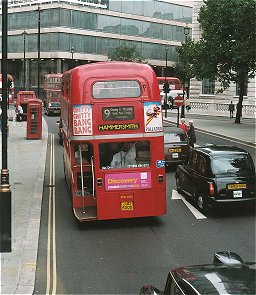 But the detractors were equally robust: they pointed to the open platform as a source of accidents,
which would never get a safety case in a new design
(although I have never seen the figures comparing accidents with closing door and open platform buses).
They pointed out the appalling economics of running old, fully-depreciated 72-seaters with two crew,
compared with running expensive new 73-seaters with a single driver.
Ignoring the experience of the 1970s they maintained that sharper acceleration and deceleration
would make up for extended dwell times at stops as passengers (sorry, customers) made enquiries of the driver.
Extra buses would not be needed to maintain capacity due to slower journeys.
Fares, of course, would not be a driver responsibility any longer in these central zones,
as all fares would be collected off-bus,
and roving teams of inspectors with severe penalties would prevent fare-dodging.
The odd high-profile prosecution of an unlikely faredodger (a sleeping nurse or a nun, for instance),
would make the point.
What is more, people pushing wheelchairs would welcome the opportunity to squeeze into the scrummage
of the open-plan lower deck.
The well-designed internal layouts of the new big buses,
with their forests of brightly coloured poles and bright lighting,
would positively welcome customers,
while the long straight staircases would encourage the less able to climb to the upper deck.
Security cameras all round would prevent unruly behaviour and window-etching.
But the detractors were equally robust: they pointed to the open platform as a source of accidents,
which would never get a safety case in a new design
(although I have never seen the figures comparing accidents with closing door and open platform buses).
They pointed out the appalling economics of running old, fully-depreciated 72-seaters with two crew,
compared with running expensive new 73-seaters with a single driver.
Ignoring the experience of the 1970s they maintained that sharper acceleration and deceleration
would make up for extended dwell times at stops as passengers (sorry, customers) made enquiries of the driver.
Extra buses would not be needed to maintain capacity due to slower journeys.
Fares, of course, would not be a driver responsibility any longer in these central zones,
as all fares would be collected off-bus,
and roving teams of inspectors with severe penalties would prevent fare-dodging.
The odd high-profile prosecution of an unlikely faredodger (a sleeping nurse or a nun, for instance),
would make the point.
What is more, people pushing wheelchairs would welcome the opportunity to squeeze into the scrummage
of the open-plan lower deck.
The well-designed internal layouts of the new big buses,
with their forests of brightly coloured poles and bright lighting,
would positively welcome customers,
while the long straight staircases would encourage the less able to climb to the upper deck.
Security cameras all round would prevent unruly behaviour and window-etching.
The sight some would like to see: the back of the Routemaster.
RML2500 (London United)
heads pell-mell from Trafalgar Square towards Picadilly on
route 9, amidst other familiar
London trappings, like the red telephone box and black cabs.
Photo taken in July 2003.
For a while it looked as though the Routemaster was due for a rosy future.
To provide opportunities for refurbishment of the RML fleet a number of the short RMs
were re-acquired by Transport for London, refurbished and pressed into service.
Jubilee Gold
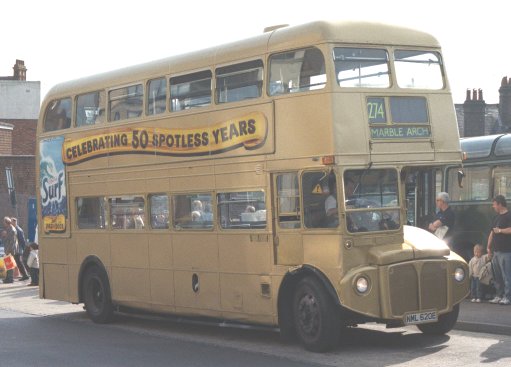 The Jubilee of the Queen's accession in 2002 saw one or more of the RMLs from each of the operating companies
covered in gold vinyl for most of the year.
It seemed like an announcement of faith in the RML as more than just a red tourist symbol for London.
Arriva London North did RML2350 and RML2750,
Centrewest produced RML2405,
London Central had RML2283 and RML2499,
London General vinylled RML2305 and RML2648,
London United RML2414 and RML2600,
Metroline RML2431 and RML2620,
and Stagecoach East London RML2450:
twelve RMLs, along with three RMs (RM6, 25 and 1650),
out of a total of fifty gold buses in London.
The Jubilee of the Queen's accession in 2002 saw one or more of the RMLs from each of the operating companies
covered in gold vinyl for most of the year.
It seemed like an announcement of faith in the RML as more than just a red tourist symbol for London.
Arriva London North did RML2350 and RML2750,
Centrewest produced RML2405,
London Central had RML2283 and RML2499,
London General vinylled RML2305 and RML2648,
London United RML2414 and RML2600,
Metroline RML2431 and RML2620,
and Stagecoach East London RML2450:
twelve RMLs, along with three RMs (RM6, 25 and 1650),
out of a total of fifty gold buses in London.
Metroline's RML2620 visited East Grinstead in April 2002,
when the golden vinyl coating was still fresh.
Route 10 splits, Route 36 gets competition
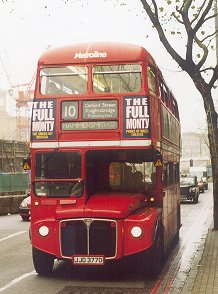 On 1st February 2003 a quiet axe began to fall.
Route 10 was divided into two, with a central overlap.
Metroline's RMLs, that had worked from Archway to Hammersmith before that date,
would now only operate from Archway to Marble Arch, as route 390.
The western arm, from Hammersmith to Kings Cross would continue as route 10,
with new low-floor double-deckers
(Centrewest provided Volvo B7TL /Alexander VFLs for this).
The frequency of Routemasters on the 390 was maintained (8 minutes),
but the shorter route required fewer buses.
Four RMLs were transferred to Willesden in February, to bolster the RML routes from there.
None were made redundant, but the reduction in requirement at Highgate
took some of the pressure off the hard-pressed RML fleet
and allowed some Metrobuses to escape to Potters Bar.
So far the RMLs seemed secure, and indeed on some routes (such as the 23) increased frequencies
meant that some Metrobuses appeared, to help out.
On 1st February 2003 a quiet axe began to fall.
Route 10 was divided into two, with a central overlap.
Metroline's RMLs, that had worked from Archway to Hammersmith before that date,
would now only operate from Archway to Marble Arch, as route 390.
The western arm, from Hammersmith to Kings Cross would continue as route 10,
with new low-floor double-deckers
(Centrewest provided Volvo B7TL /Alexander VFLs for this).
The frequency of Routemasters on the 390 was maintained (8 minutes),
but the shorter route required fewer buses.
Four RMLs were transferred to Willesden in February, to bolster the RML routes from there.
None were made redundant, but the reduction in requirement at Highgate
took some of the pressure off the hard-pressed RML fleet
and allowed some Metrobuses to escape to Potters Bar.
So far the RMLs seemed secure, and indeed on some routes (such as the 23) increased frequencies
meant that some Metrobuses appeared, to help out.
A week later a more signicant chop was made. Route 36, operated by New Cross RMs,
was significantly reduced, while new articulated Mercedes buses started cashless operation on the 436,
along the same corridor, with off-bus ticket purchase. This proved quite popular.
Twenty-four RMs were taken out of New Cross. Some were returned to London Buses, using the old Walworth garage,
and some were redistributed to increase frequencies and reliability on RML routes.
RMs went to Putney for the 22, to Westbourne Park, and to Stockwell fotr the 11.
Then some were taken back from TfL by London Central in exchange for four RMLs, which also went to Metroline at Willesden.
RML2377 passes Kings Cross in December 2002,
when the 10 still went to Hammersmith (Metroline).
Farewell to the 15: first major RML sales
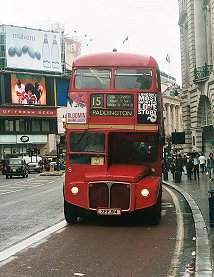
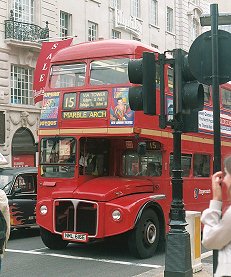 On 29th August 2003 the 15 ran its last Routemasters.
Upton Park had gradually run down the fleet during the previous month,
slipping the replacement Tridents into service.
At least they gave the RMLs a send-off, with special appearances by RTL139 and RT3871 running in service,
and guest appearances on earlier days by RT1702 and RT3871.
On the final evening RML2760 (still AEC engined and unrefurbished), RMC1461 and RMC1456 were in service,
together with RML2456 which had been repainted into green livery. RML2760 was the last to run in on service.
On 29th August 2003 the 15 ran its last Routemasters.
Upton Park had gradually run down the fleet during the previous month,
slipping the replacement Tridents into service.
At least they gave the RMLs a send-off, with special appearances by RTL139 and RT3871 running in service,
and guest appearances on earlier days by RT1702 and RT3871.
On the final evening RML2760 (still AEC engined and unrefurbished), RMC1461 and RMC1456 were in service,
together with RML2456 which had been repainted into green livery. RML2760 was the last to run in on service.
RM890, in its last month of operation, turns the corner in Regent Street, leaving Piccadilly on the 15.
RML2616, despite its smart appearance here in July, as it waits to enter Piccadilly Circus from Lower Regent Street,
was disposed of to Ensign in early September.
Eighteen of the RMLs were promptly sold to Ensign Bus, together with four RMs.
RML 898 went to Blue Triangle, RMC1485 went to Lothian Regional Transport,
green RMC1461 went to Cobham Museum, red RMC1456 went for preservation, as did RM613.
Three RMLs went back to Transport for London, and went to Arriva London.
The other seven were transferred to Bow for service on route 8:
these included the two "specials", green RML2456 and "last" RML2760.
Exit from the 11
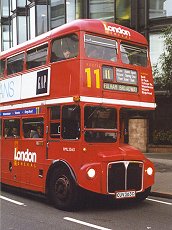
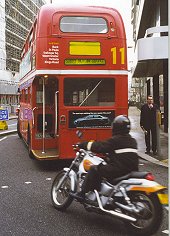 31st October 2003 saw a further swathe cut through the RML fleet.
This time it was London General's route 11, perhaps the most famous tourist route of all,
connecting the City with Westminster and Victoria. But the WVLs were coming, and the RMLs were going.
No public fanfare. Word went round the enthusiast grapevine, and there was a wake of sorts on the last day.
London General pulled out two of its specials for the day, RM9 and door-fitted DRM2516,
and RM1 came round for photographs but not public bottoms.
Privately preserved RTW467 also ran along the route,
although it could not pick up members of the public.
31st October 2003 saw a further swathe cut through the RML fleet.
This time it was London General's route 11, perhaps the most famous tourist route of all,
connecting the City with Westminster and Victoria. But the WVLs were coming, and the RMLs were going.
No public fanfare. Word went round the enthusiast grapevine, and there was a wake of sorts on the last day.
London General pulled out two of its specials for the day, RM9 and door-fitted DRM2516,
and RM1 came round for photographs but not public bottoms.
Privately preserved RTW467 also ran along the route,
although it could not pick up members of the public.
London General then redistributed its RMLs, understandably keeping the best,
and dispatching twenty-two to Ensigns.
I missed out on seeing the 11 during 2003 (and for some years before,
as I usually pass through London on a Sunday, when its RMs have not been operating).
So these two pictures date from October 1998, on a Monday morning near St.Paul's Cathedral.
The "Sorry Not in Service" on the back of departing RML2342 says it all.
Goodbye to the 23
 A fortnight later, on 14th November 2003, it was First Centrewest's turn to replace their RMLs.
More articulated buses were to blame, but those were for route 18.
But they had displaced four-year-old Tridents, which would come to displace the RMLs for a while
before going elsewhere (as slightly "old" new buses) to replace older front-door non-low-floor buses in the First London fleet.
Anyway, the RMLs on Westbourne Park garage's route 23 were out.
A fortnight later, on 14th November 2003, it was First Centrewest's turn to replace their RMLs.
More articulated buses were to blame, but those were for route 18.
But they had displaced four-year-old Tridents, which would come to displace the RMLs for a while
before going elsewhere (as slightly "old" new buses) to replace older front-door non-low-floor buses in the First London fleet.
Anyway, the RMLs on Westbourne Park garage's route 23 were out.
Again there were quiet jollifications on the last evening, with senior people driving and conducting the last bus (RML885).
RT4421 operated during the day,
and the last run had duplicates in the shape of preserved RM613 and Stagecoach's green RML2456 (both fresh from the 15).
Blue Triangle's RCL2260 also came along for the ride.
Seven RMs, including five of the Marshall refurbs, passed back to TfL for onward passage to Arriva London at Battersea,
eight RMLs were sent off to First Glasgow, and another three were stored.
RML2506 comes down Regent Street to Piccadilly in July 2003,
with four months to go before storage.
Part Six: 2004: Endgame?

 Part Four: the nineties
Part Four: the nineties
 Part Six: Endgame?
Part Six: Endgame?
 photo references
photo references
 bus histories
bus histories
 Ian's Bus Stop
Ian's Bus Stop
 RM Contents
RM Contents
 RCLs
RCLs
 RMLs
RMLs
 RMFs
RMFs
|

